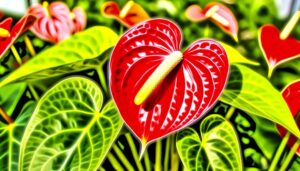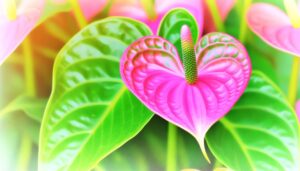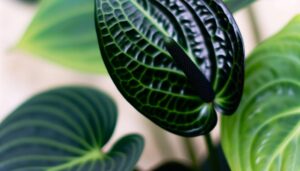What Makes Anthurium Black Queen Unique? Discover!
The Anthurium Black Queen stands out with its nearly ebony, velvety leaves, providing a lush and exotic allure. Its foliage has a soft texture and a rich gloss.
The plant’s spadix and spathe structure is intricate, adding to its singularity. It’s considered a rare species due to limited habitat and challenging cultivation.
For best growth, you’ll need well-draining soil, high humidity (60-80%), bright indirect sunlight, and careful watering to prevent root rot. If you’re curious about propagation techniques and detailed care tips, you’re in for more intriguing details.
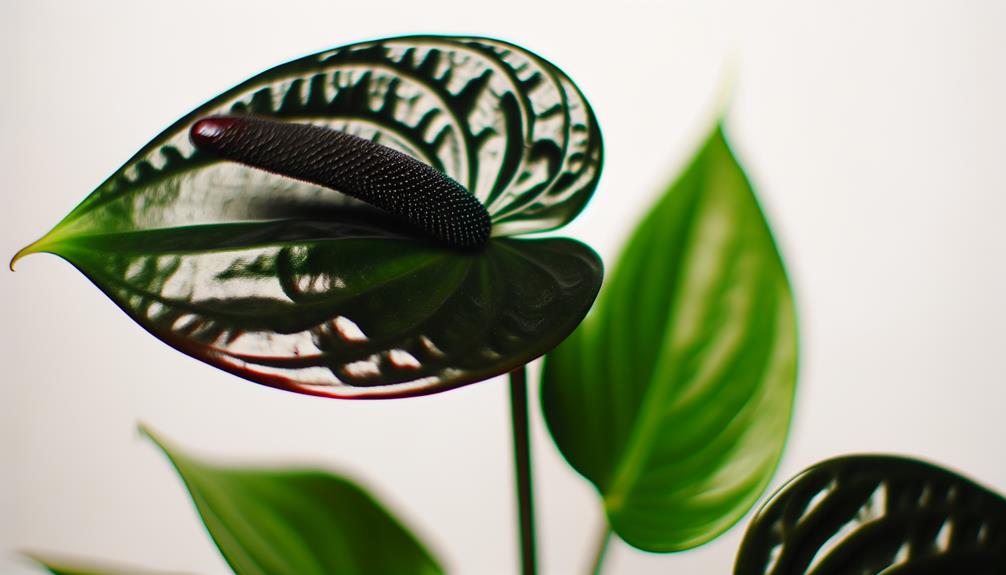
Key Takeaways
- Anthurium Black Queen features striking, almost black, velvety leaves.
- Its leaves have a rich sheen and a soft touch sensation.
- The plant has an exotic appeal with a unique spadix and spathe structure.
- It is a rare plant due to limited habitat and cultivation challenges.
- The unique flower structure includes an intricate spadix and spathe combination.
Striking Dark Foliage
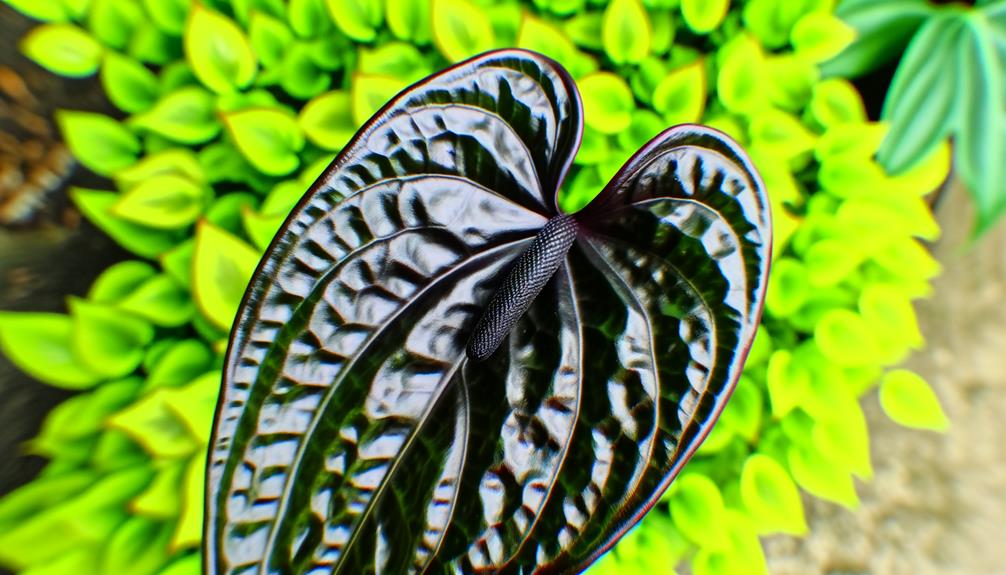
The Anthurium Black Queen captivates with its striking dark foliage, characterized by deep, almost black, velvety leaves that exhibit a glossy sheen.
You’ll notice that each leaf is heart-shaped, with prominent veins that create a dramatic contrast against the dark backdrop.
These leaves aren’t just visually stunning; they’re also robust, capable of thriving in lower light conditions, which makes them perfect for indoor cultivation.
The dark pigmentation results from high concentrations of anthocyanins, natural compounds that protect the plant from UV light and pathogens.
When you place this plant in your home, it doesn’t just add aesthetic value; it also brings a touch of botanical sophistication. The unique coloration and resilience of the Anthurium Black Queen make it a coveted choice for plant enthusiasts.
Velvet Leaf Texture
You’ll notice the Anthurium Black Queen‘s leaves exhibit a rich velvet sheen, enhancing their dramatic appearance.
Each leaf’s texture provides a soft touch sensation, akin to brushed suede, making it a tactile delight.
This unique combination of visual and tactile properties sets this plant apart in any botanical collection.
Rich Velvet Sheen
Each leaf of the Anthurium Black Queen boasts a rich velvet sheen, characterized by its dense, velvety texture and deep, dark hue that enhances its striking appearance.
You’ll notice the intricate network of veins, which are accentuated by the leaf’s unique luster. The chlorophyll within these leaves absorbs light efficiently, giving them a bold, almost surreal quality.
This luxuriant sheen isn’t just eye-catching; it also indicates the plant’s robust health. The velvety epidermis minimizes water loss and reflects light, creating that signature glimmer.
Each leaf’s surface is microscopically covered with tiny trichomes, which contribute to its distinctive texture. This botanical marvel captures and reflects light, imbuing your Anthurium Black Queen with an enigmatic charm that’s hard to resist.
Soft Touch Sensation
Running your fingers over the Anthurium Black Queen’s leaves, you’ll instantly notice the soft, velvety texture that sets this plant apart.
This tactile sensation arises from the unique epidermal cells on the leaf surface, which create a plush, almost suede-like feel.
The velvety leaves also contribute to the plant’s overall allure, making it a standout in any collection.
Consider these key features:
- Microscopic Trichomes: Tiny hair-like structures that reduce water loss and provide the leaf’s velvety touch.
- Cuticle Layer: A waxy coating that enhances the leaf’s tactile softness while protecting against pathogens.
- Leaf Morphology: Broad, heart-shaped leaves with a rich, deep green hue that intensifies the plant’s luxurious feel.
These elements combine to offer an unrivaled sensory experience.
Exotic Appeal
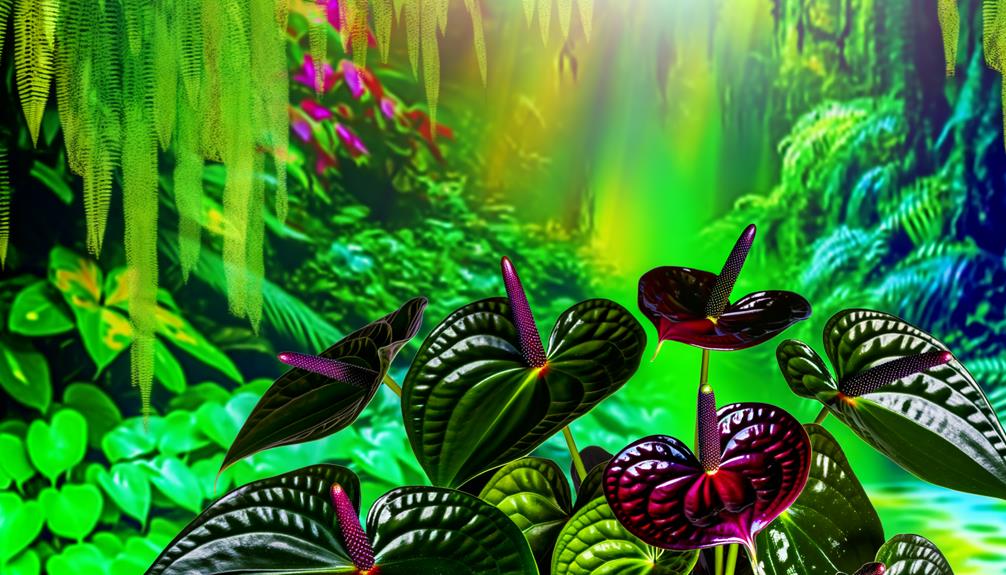
You’ll find the Anthurium Black Queen‘s striking dark foliage offers a dramatic contrast to its unique spadix and spathe structure.
The deep, almost black leaves enhance the plant’s exotic appeal, creating an elegant visual juxtaposition with any surrounding greenery.
Its sophisticated appearance makes it a standout addition to any botanical collection.
Striking Dark Foliage
The Anthurium Black Queen captivates with its striking dark foliage, characterized by deep, almost black leaves that create an exotic and dramatic visual impact in any setting.
These leaves aren’t just visually appealing; they also have a velvety texture that enhances their luxurious appearance.
Their heart-shaped form and prominent veining add to the plant’s allure, making it a standout in any collection.
To fully appreciate its exotic appeal, consider:
- Color: The leaves’ near-black hue contrasts beautifully with lighter surroundings.
- Texture: The velvety surface provides a tactile experience that’s rare in houseplants.
- Shape: The heart-shaped leaves with pronounced veins offer a unique, eye-catching structure.
Immerse yourself in the Anthurium Black Queen’s mystique and let its dark foliage enchant your space.
Elegant Visual Contrast
Focusing on the interplay between textures and colors, the Anthurium Black Queen captivates with its dark, velvety leaves juxtaposed against the glossy, vibrant spathe and spadix. This striking contrast creates an exotic appeal that’s hard to ignore.
You’ll notice how the matte finish of the foliage enhances the lustrous appearance of the flowers, drawing the eye immediately.
Consider the following aspects for a deeper appreciation:
- Leaf Texture: The velvety leaves provide a soft, tactile experience.
- Color Contrast: Dark leaves against bright flowers create a dramatic visual effect.
- Spathe and Spadix: The glossy spathe and spadix offer a striking focal point.
Rare Plant Status
Regarding its rare plant status, Anthurium Black Queen’s limited natural habitat and challenging cultivation requirements make it a sought-after specimen among botanical enthusiasts.
You’ll find it primarily in specific tropical microclimates, where humidity and temperature conditions are near perfect. Its propagation is notoriously difficult, requiring expert knowledge of phytopathology and precise control over environmental variables.
You must maintain high humidity levels, consistent temperatures, and well-draining, organic-rich soil to mimic its native conditions.
The plant’s slow growth rate further adds to its rarity, as it takes years to reach maturity. These factors combine to create a high demand and low supply scenario, making the Anthurium Black Queen a true collector’s gem.
Your dedication to its care will be richly rewarded with a stunning, rare plant.
Unique Flower Structure
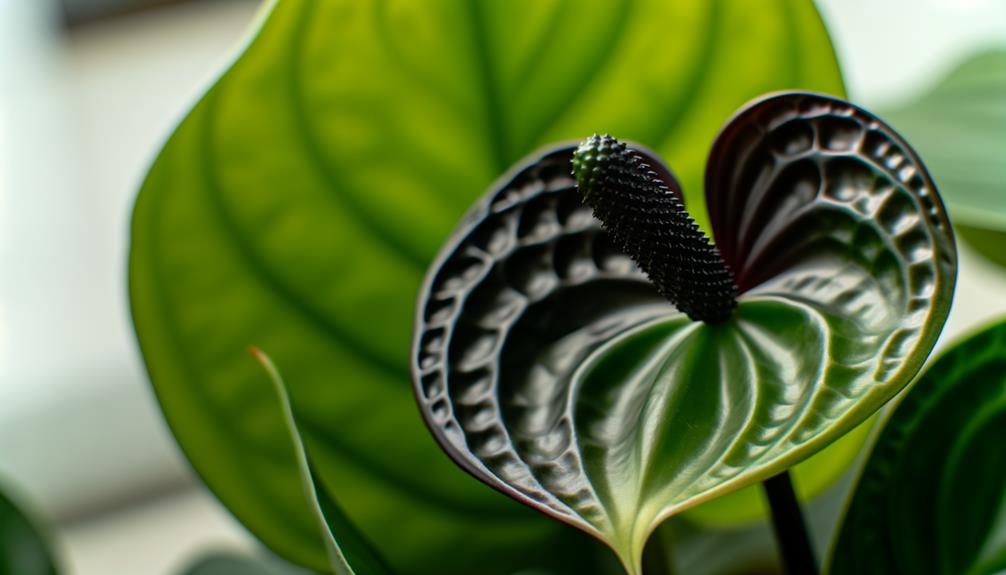
Have you ever marveled at the intricate spadix and spathe combination that characterizes the Anthurium Black Queen’s unique flower structure?
The spadix, a cylindrical structure, houses numerous tiny flowers packed tightly together. It’s surrounded by the spathe, a modified leaf that’s not only protective but also strikingly ornamental.
Consider the following features:
- Coloration: The spathe is a deep, velvety black-purple hue, contrasting sharply with the spadix.
- Texture: The spathe’s surface is smooth and glossy, adding a touch of elegance.
- Form: The spadix often curves gracefully, creating an alluring silhouette.
This botanical marvel’s structure isn’t just visually stunning; it’s also a fascinating adaptation for attracting pollinators while protecting the reproductive organs.
Care Requirements
To ensure the Anthurium Black Queen thrives, you’ll need to provide it with well-draining soil, consistent humidity, and indirect light.
Use a mix of orchid bark, peat, and perlite for prime root aeration. Maintain humidity levels around 60-80% by misting or using a humidifier.
Position your plant in a spot with bright, indirect sunlight, avoiding direct rays that may scorch the leaves.
Water when the top inch of soil feels dry, making certain excess water drains away to prevent root rot.
| Requirement | Ideal Condition | Notes |
|---|---|---|
| Soil | Well-draining mix | Orchid bark, peat, and perlite preferred |
| Humidity | 60-80% | Use misting or a humidifier |
| Light | Bright, indirect sunlight | Avoid direct sun exposure |
| Watering | When top inch is dry | Ensure proper drainage |
These steps will help keep your Anthurium Black Queen in peak health.
Propagation Tips
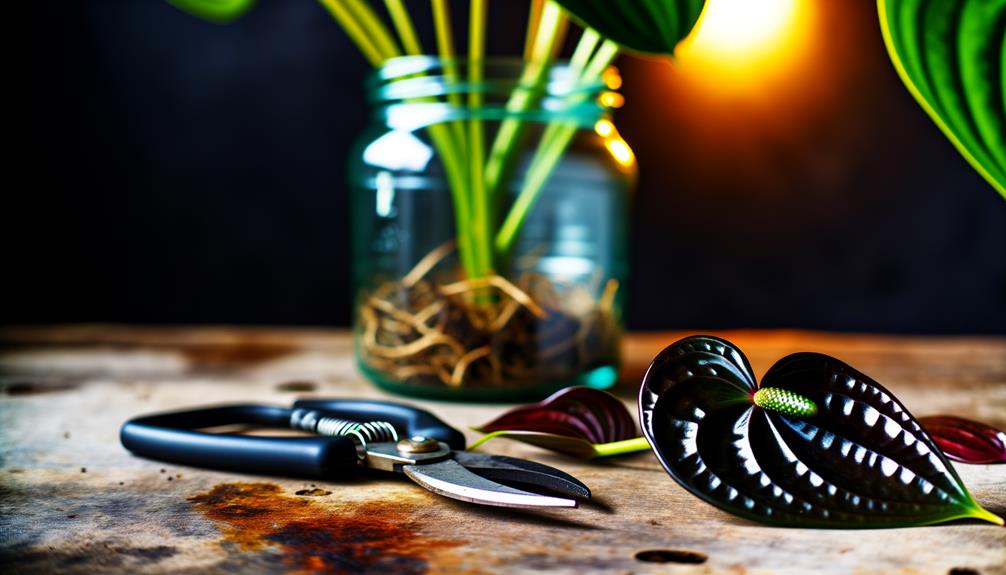
Propagating the Anthurium Black Queen involves taking stem cuttings with at least one node and a couple of healthy leaves.
You’ll want to use sterilized pruning shears to make a clean cut, ensuring best health for both the mother plant and the cutting.
To encourage root development, place the cutting in a well-draining, aerated medium like sphagnum moss or perlite.
Remember these key steps:
- Sterilize Tools: Always sterilize your pruning shears to prevent infections.
- Rooting Medium: Choose a medium that retains moisture but allows airflow.
- Humidity Control: Maintain high humidity levels around the cutting to facilitate root growth.
Conclusion
You won’t find another plant as mesmerizing as the Anthurium Black Queen. Its striking dark foliage and velvety leaf texture make it a showstopper in any collection.
The exotic appeal and rare status elevate it to legendary status among botanists. Its unique flower structure is a marvel of nature.
With proper care and propagation, you’ll witness firsthand the unparalleled magnificence of this botanical gem. Don’t miss out on cultivating this horticultural masterpiece!

